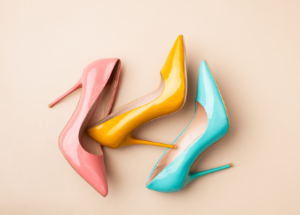Whether it be stiletto, platform or wedge high heels, nothing tops an outfit like the addition of high heels. Crafted by top designers such as Roger Vivier, Jimmy Choo, Manolo Blahnik and Alexander McQueen, high heels lengthen legs while giving women the illusion that they’re taller.
 High heels force hip flexor muscles into an inflexed position that may shorten and weaken them over time.
High heels force hip flexor muscles into an inflexed position that may shorten and weaken them over time.
They Elevate Your Outfit
An appropriate heel can elevate any look by creating proportionate balance and adding feminine style. For instance, wide-leg trousers and midi skirts cannot be worn with flat shoes; to maintain the line of these pieces of clothing or pants requires heels. Furthermore, good heels create feminine silhouettes and emphasise calves for slimmer appearances.
High heels can improve posture, which is essential to health and confidence. In addition, high heels can elongate legs to make them appear thinner while relieving certain medical conditions by shifting weight away from the centre of gravity onto one of your feet.
Heels come in all forms – from stilettos to kitten heels – but regardless of height, they should provide support and be comfortable for wearers. When beginning with heels, it’s wise to start small; selecting shoes that fit well will minimise any frictional effects; test out new pairs late in the day when your feet have less swelling.
For maximum comfort, the ideal high heels feature a padded insole and lightweight construction from platform to heel, which makes them extremely wearable from day one. If you’re struggling to find shoes you can wear all day, check out Stitch Fix’s Elite Comfort Heels service: take their style quiz and receive five curated pieces sent directly to you; buy what you love or return what doesn’t – it’s free!
They Make You Feel Like a Warrior
People often see high heels as symbols of strength; however, this perception can be misleading. Women often struggle to walk comfortably in high heels such as stilettos. That is because these styles change how you walk by shifting weight onto one foot over time while taking some stress away from another – making balancing difficult and increasing chances of trips and falls.
Heels make dancing difficult because they make it difficult to flex your ankle, making dancing in them challenging. If heels make you uneasy, flats or low-heeled pumps may be more suitable – although even experienced wearers should limit how often they wear heels to an event or outfit.
Heels come in various styles, from thin stiletto-like designs to thick chunky models. You’ll even find wedges, block heels, wedge boots, or ordinary oxfords! No matter their design, all heels have one thing in common: elevating your look by providing extra height. They’re also an effective way to elongate legs – make sure that before wearing them for extended periods, you practice walking and standing in them to ensure comfort!
They’re a Fetish
High heels have long been a fashion accessory from ancient Egypt to today. While originally worn by men, in the 17th century, they became popular as women’s fashion accessories, with stiletto heels associated with femininity and power. By the 20th century, Hollywood actresses like Marilyn Monroe and Audrey Hepburn popularised women’s high heels as everyday wear. They can now be found everywhere, from formal events to the workplace!
High heels have long been associated with femininity and sexuality, often creating appealing sexual imagery for some individuals. Their elongating effect makes women appear thinner and seductive; furthermore, some men become attracted to women wearing heels.
However, many men find the cultural expectation for women to wear high heels problematic, as long-term use may cause joint and vein issues. Furthermore, some have even protested dress codes that require women to wear heels in professional environments.
They’re a Weapon
Heels are the female equivalent of suits and ties: they signal power, stability, and success while serving as a crutch that holds us back. Sheryl Sandberg, Dolly Singh, and Marissa Mayer – are just three high-powered examples- would likely be accused of unprofessionalism for showing up to work wearing Converse or flat shoes: accusers would accuse them of showing signs of incompetence or weak leadership – it’s no wonder then that heels have become such an essential symbol of femininity required at balls or red carpet events where men take women less seriously without wearing heels!